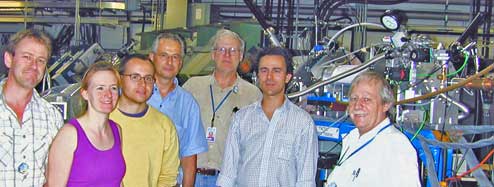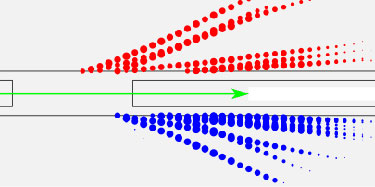
TACTIC (TRIUMF Annular Chamber for Tracking and Identification of Charged Particles) is a cylindrical time projection chamber for the detection of low-energy ions ejected from nuclear reactions built by a collaboration between the University of York and TRIUMF. The chamber allows the three-dimensional reconstruction of ion tracks by means of a two-dimensional anode array combined with a time-of-flight measurement of the drift electrons. It will be used to measure the strength of nuclear reactions of significant astrophysical importance that occur in stars such as the reactions that influence the nucleosynthesis of heavy elements during supernovae explosions.
On August 30, 2007, the chamber received its first beam from the ISAC radioactive ion beam facility. A beam of approximately 13,000 Boron-11 nuclei per second entered the chamber, which was filled with a mixture of helium and carbon dioxide. Elastically scattered Boron-11 nuclei entered the drift region leaving behind a trail of electrons ripped from the atoms of gas as the nuclei passed by. These electrons drifted to the detector anodes and were collected by the chamber electronics. From the electron signals and their timing, the tracks of the nuclei were reconstructed (see Figure above). The Boron-11 tracks shown are from opposite sectors of the cylindrical chamber. The size of the dots indicates the size of the electron signal. The green arrow marks the beam direction. Inside the target area, the tracks are not detected. The beam tracks would overwhelm the signal. Tracks originate from beam scattering on gas molecules in the rectangular area to the left. Outside of this, the beam passes through vacuum.
TACTIC was built by a collaboration of 16 scientists from the University of York and TRIUMF. The York and TRIUMF experimenters on hand for this occasion were (from left to right in banner photo: Simon Fox, Alison Laird, and Paul Mumby-Croft, [University of York], Pierre Amaudruz, Pat Walden, Götz Ruprecht, and Robert Openshaw [TRIUMF]. TACTIC is the apparatus on the right). The data being collected will form the thesis of Paul Mumby-Croft.
The chamber will now undergo various commissioning tests and calibrations. Off-line analysis of the data will establish detector performance. Formal experiments with radioactive beam will be scheduled in 2008.

Boron-11 Tracks on Computer
